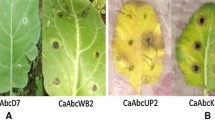Abstract
Eighty isolates ofVerticillium dahliae from the southeastern Anatolia region and 20 isolates from the east Mediterranean region from wilted cotton plants were used for vegetative compatibility analysis employing nitrate non-utilizing mutants and reference tester strains of vegetative compatibility groups (VCGs) 1A, 2A, 2B, 3, 4A and 4B. Of the 100V. dahliae isolates, 49 were assigned to VCG1A, 39 to VCG2B, nine to VCG2A and three to VCG4B. Pathogenicity assays were conducted on susceptible cotton cv. Çukurova 1518 in the greenhouse. All VCG1A isolates induced defoliation and all VCG2B isolates caused partial defoliation symptoms. Isolates of VCG2A and VCG4B caused typical symptoms of leaf chlorosis without defoliation. This is the first report on VCGs ofV. dahliae in the southeastern Anatolia region of Turkey, which demonstrates that VCG1A of the cotton-defoliating type and VCG2B of the partially defoliating type are prevalent in this region.
Similar content being viewed by others
References
Bejarano-Alcázar, J., Melero-Vara, J.M., Blanco-López, M.A. and Jıménez-Díaz, R.M. (1995) Influence of inoculum density of defoliating and nondefoliating pathotypes ofVerticillium dahliae on epidemics of Verticillium wilt of cotton in southern Spain.Phytopathology 85:1474–1481.
Bell, A.A. (1992) Verticillium wilt.in: Hillocks, R.J. [Ed.] Cotton Diseases. C.A.B. International, Oxford, UK. pp. 87–126.
Bell, A.A. (1994) Mechanisms of disease resistance inGossypium and variation inVerticillium dahliae. Proc. World Cotton Res. Conf. — 1 (CSIRO, Melbourne, Australia), pp. 225–235.
Bhat, R.G., Smith, R.F., Koike, S.T., Wu, B.M. and Subbarao, K.V. (2003) Characterization ofVerticillium dahliae isolates and wilt epidemics of pepper.Plant Dis. 87:789–797.
Chandelier, A., Laurent, F., Dantinne, D., Mariage, L., Etienne, M. and Cavalier, M. (2003) Genetic and molecular characterization ofVerticillium dahliae from woody ornamentals in Belgian nurseries.Eur. J. Plant Pathol. 109:943–952.
Chen, W. (1994) Vegetative compatibility groups ofVerticillium dahliae ornamental woody plants.Phytopathology 84:214–219.
Correll, J.C., Klittich, C.J.R. and Leslie, J.F. (1987) Nitrate nonutilizing mutants ofFusarium oxysporum and their use in vegetative compatibility tests.Phytopathology 77:1640–1646.
Daayf, F., Nicole, M. and Geiger, J.P. (1995) Differentiation ofVerticillium dahliae on the basis of vegetative compatibility and pathogenicity on cotton.Eur. J. Plant Pathol. 101:69–79.
Dervis, S. and Bicici, M. (2005) Vegetative compatibility groups inVerticillium dahliae isolates from cotton in Turkey.Phytoparasitica 33:157–168.
Dobinson, K.F., Harrington, M.A., Omer, M. and Rowe, R.C. (2000) Molecular characterization of vegetative compatibility group 4A and 4B isolates ofVerticillium dahliae associated with potato early dying.Plant Dis. 84:1241–1245.
Elena, K. (1999) Genetic relationships amongVerticillium dahliae from cotton in Greece based on vegetative compatibility.Eur. J. Plant Pathol. 105:609–616.
Göre, E. (2007) Vegetative compatibility and pathogenicity ofVerticillium dahliae from the Aegean Region of Turkey.Phytoparasitica 35:222–231.
Jiménez-Díaz, R.M., Mercado-Blanco, J., Olivares-García, C., Collado-Romero, M., Bejarano-Alcázar, J., Rodríguez-Jurado, D.et al. (2006) Genetic and virulence diversity inVerticillium dahliae populations infecting artichoke in eastern-central Spain.Phytopathology 96:288–298.
Joaquim, T.R. and Rowe, R.C. (1990) Reassessment of vegetative compatibility relationships among strains ofVerticillium dahliae using nitrate non-utilizing mutants.Phytopathology 80:1160–1166.
Katan, T. (2000) Vegetative compatibility in populations ofVerticillium — An overview.in: Tjamos, E.C., Rowe, R.C., Heale, J.B. and Fravel, D.R. [Eds.] Advances inVerticillium Research and Disease Management. The American Phytopathological Society, St. Paul, MN, USA. pp. 77–94.
Korolev, N., Katan, J. and Katan, T. (2000) Vegetative compatibility groups ofVerticillium dahliae in Israel: Their distribution and association with pathogenicity.Phytopathology 90:529–566.
Korolev, N. and Katan, T. (1997) Improved medium for selecting nitrate nonutilizing (nit) mutants ofVerticillium dahliae.Phytopathology 87:1067–1070.
Korolev, N., Pérez-Artés, E., Bejarano-Alcázar, J., Rodríguez-Jurado, D., Katan, J., Katan, T.et al. (2001) Comparative study of genetic diversity and pathogenicity among populations ofVerticillium dahliae cotton in Spain and Israel.Eur. J. Plant Pathol. 107:443–456.
Pegg, G.F. and Brady, B.L. (2002) Verticillium Wilts. CAB International, Oxford, UK.
Pérez-Artés, E., García-Pedrajas, M.D., Bejarano-Alcázar, J. and Jiménez-Díaz, R.M. (2000) Differentiation of cotton-defoliating and nondefoliating pathotypes ofVerticillium dahliae by RAPD and specific PCR analyses.Eur. J. Plant Pathol. 106:507–517.
Schnathorst, W.C. and Mathre, D.E. (1966) Host range and differentiation of a severe form ofVerticillium albo-atrum cotton.Phytopathology 56:1155–1161.
Smith, H.C. (1965) The morphology ofVerticillium albo-atrum, V. dahliae, andV. tricopus.N.Z.J. Agric. Res. 8:450–478.
SPSS (2004) Base 13.0 User’s Guide. SPSS Inc., Chicago, IL, USA.
Strausbaugh, C.A. (1993) Assessment of vegetative compatibility and virulence ofVerticillium dahliae from Idaho potatoes and tester strains.Phytopathology 83:1253–1258.
Zhengjun, X., Achar, P.N. and Benkang, G. (1998) Vegetative compatibility groupings ofVerticillium dahliae from cotton in mainland China.Eur. J. Plant Pathol. 104:871–876.
Author information
Authors and Affiliations
Corresponding author
Additional information
http://www.phytoparasitica.org posting Dec. 25, 2007.
Rights and permissions
About this article
Cite this article
Dervis, S., Kurt, S., Soylu, S. et al. Vegetative compatibility groups ofVerticillium dahliae from cotton in the southeastern anatolia region of Turkey. Phytoparasitica 36, 74–83 (2008). https://doi.org/10.1007/BF02980750
Received:
Accepted:
Issue Date:
DOI: https://doi.org/10.1007/BF02980750



